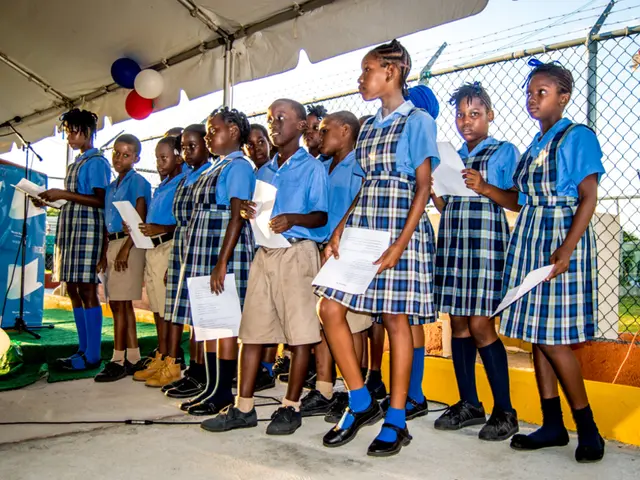Uncensored and Unleashed: The Power of Positive Reinforcement
Five Strategies to Stimulate Desirable Actions through Encouragement and Rewards
Stuck in a never-ending struggle to maintain order and foster an effective learning environment? Ditch the draconian tactics and tap into the raw power of positive reinforcement. This method, which focuses on praising, rewarding, and teaching instead of punishing, represents the key to success when dealing with young minds.
Originating in the 1940s from the mind of the influential American psychologist B.F. Skinner, positive reinforcement might seem like a controversial concept—especially when compared to the reign of strict rules and disciplinary action. But don't be fooled; this approach has been widely backed by countless scientific studies, demonstrating its effectiveness in shaping behavior.
Essentially, positive reinforcement is about rewarding desired behaviors, rather than doling out punishment for undesirable ones. For instance, recognizing a student's diligent work ethic by showering them with compliments or providing incentives can significantly boost their motivation, making their learning experience far more rewarding.
The Nitty-Gritty of Positive Reinforcement
Embracing the Tides of Good Behavior
Positive reinforcement isn't merely a tool for discouraging bad behavior; it's also an effective means of encouraging good behavior by making those actions more likely to recur. And who better to demonstrate the reality of that statement than our beloved furry friends? Any dog owner knows that a hearty round of praise or a delicious treat following a well-executed trick makes it exponentially easier to recreate that behavior. Applying this same philosophy to the classroom yields similarly stunning results.
Harnessing the Past: B.F. Skinner's Contributions to Positive Reinforcement
At the heart of positive reinforcement lies the concept of operant conditioning. Skinner's groundbreaking studies on operant conditioning revealed that reinforcing positive actions caused those actions to occur more frequently. This simple yet powerful idea is rooted in Thorndike's Law of Effect, which states that actions are repeated based on their outcomes.
The Evolution of Positive Reinforcement: A Look at the Research
Studies have consistently supported the effectiveness of positive reinforcement in the classroom, indicating that children are far more likely to engage in positive behaviors when they are rewarded rather than when they are punished for negative actions. A study conducted at Brigham Young University, for instance, found that children aged 5-12 were able to focus up to 30% more when their learning experience was accompanied by positive reinforcement.
Channeling Your Inner Teacher: Five Positive Reinforcement Strategies
To harness the power of positive reinforcement, it's essential to approach this strategy with a thoughtful, diverse mindset. Adopting a range of techniques keeps students engaged and motivated, ensuring a supportive learning environment where everybody flourishes.
Embracing a Strategic, Versatile Approach to Reinforcement
To make positive reinforcement work, begin by identifying the behaviors you wish to encourage and select a diverse mix of techniques that will resonate with your students. Utilize a harmonious blend of verbal praise, body language, rewards, and personalized gestures to create a dynamic, engaging environment.
Vermin Praise and Pronged Praise: The Dynamics of Praising Your Students
While verbal praise is crucial, it's essential to further sophisticate your approach by employing a variety of tones and styles to cater to different personalities and scenarios. For example, offering quiet, heartfelt compliments to introverted students or praising demonstrative students in front of their peers can make everyone feel noticed and appreciated.
Chasing the Carrot: Reinforce Your Students with Incentives
Smaller, immediate rewards can be highly motivating for students. Consider offering items such as stickers, points, or even small indulgences to reward their achievements. Group rewards that foster teamwork and competition are also an excellent means of encouraging students to work together.
The Power of Praise Preferences: Understanding Your Students' Needs
It's crucial to understand that every student responds differently to praise, so it's vital to discover and leverage each student's unique praise preferences to make your encouragement as effective as possible. By knowing your students, you can develop a classroom environment where positive reinforcement, personalities, and praise preferences all work harmoniously to help your students reach their full potential.
"Employing a 4:1 praise-to-criticism ratio is key. This ensures that for every negative comment, there are a minimum of four positive comments to offset it."
Building Your Own Fiefdom: Designing a Reward System
A well-structured reward system can significantly bolster student motivation, teamwork, and cooperation. To develop a reward system that works for you, avoid limiting your rewards to the same tired prizes. Instead, focus on rewarding student effort and progress, ensuring that your incentives resonate with each student and the overall classroom dynamic.
Handling the Fickle Nature of Human Beings: Positive Reinforcement for Good Behavior
Positive reinforcement is a potent tool for promoting good behavior in the classroom. Always reward the good behavior and avoid doling out praise for negative ones. Positive reinforcement is about providing prompt, specific rewards that cater to each student's unique needs.
Rewarding the Good: Small Gestures with Huge Impact
Praise, sticks, or small treats can all serve as effective rewards for good behavior. The secret to success lies in matching your rewards to the students and situations. A study found that combining verbal praise with positive reinforcements can significantly improve students' focus, cooperation, and attentiveness in the classroom.
Timely Praise: The Importance of Striking While the Iron is Hot
Time is of the essence when it comes to positive reinforcement. Delaying positive feedback can diminish its impact, so it's essential to offer praise immediately whenever you witness a desired behavior.
Immediate praise reinforces the connection between the behavior and the reward, making the behavior more likely to recur. Use a mix of verbal praise, body language, and quick rewards to acknowledge success when you see it.
Caution: Setting Unrealistic Expectations and Overpraising
When attempting to improve student behavior, it's essential to set realistic, achievable goals. Celebrating small steps forward gives students a positive sense of accomplishment, no matter how small the victory may seem. In contrast, relying too heavily on big rewards can dilute the overall effectiveness of positive reinforcement, ultimately stifling students' motivation to strive for more.
Understand Your Students: Tailoring Praise to Fit Their Needs
Different students react to praise in various ways; some might appreciate verbal compliments, while others benefit from private, heartfelt gestures. To make positive reinforcement more effective, it's crucial to understand each student's unique praise preferences. By fostering open communication with your students, you can tailor your praise to their preferences, building stronger bonds and creating a more supportive learning environment.
Achieving Success: Implementing Positive Reinforcement Strategies
- Identify Desired Behaviors: Determine which behaviors you wish to encourage in your classroom.
- Select Reinforcement Methods: Choose reinforcement techniques that best suit the behaviors you wish to foster and resonate with your students.
- Develop a Reward System: Establish a clear and creative reward system to reinforce the desired behaviors consistently and effectively.
Positive reinforcement has the potential to revolutionize the classroom environment, fostering stronger, more motivated students who love learning and embrace new challenges. With a thoughtful, adaptable approach to positive reinforcement, educators can create an atmosphere where every student has the opportunity to thrive.
- In the process of cultivating a stimulating learning environment, utilizing positive reinforcement over strict punishments can significantly enhance students' respect for boundaries and encourage self-development, leading to personal growth through education-and-self-development.
- By recognizing and praising desired behaviors such as diligent work ethic, educators can reinforce learning by providing appropriate boundaries for students, promoting a balanced and harmonious educational experience that encourages both positive behavior and personal growth, driven by the motivation of learning.






